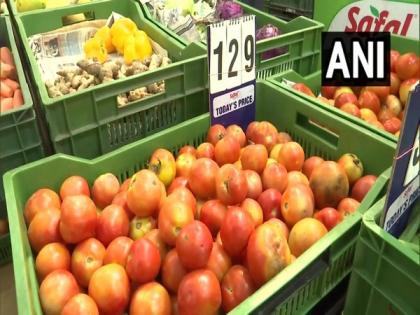Tomatoes out of commoners' reach in India; selling at over Rs 100
By ANI | Published: July 5, 2023 07:23 PM2023-07-05T19:23:22+5:302023-07-05T19:25:11+5:30
New Delhi [India], July 5 : Tomators are now red-hot and burning a hole in the common people's pockets ...

Tomatoes out of commoners' reach in India; selling at over Rs 100
New Delhi [India], July 5 : Tomators are now red-hot and burning a hole in the common people's pockets as the prices have skyrocketed and are being sold at over Rs 100 per kg in several key cities.
Many attribute the sharp rise in the vegetable to heatwaves in key tomato-growing areas and heavy rains, as well, as disruption in supply chains. Tomatoes, which have a relatively lower shelf life, could also have put pressure on their prices.
In Chennai, tomatoes are currently selling at Rs 100-130 per kg.
Faced with price prices, the Tamil Nadu Government has started the sale of tomatoes at a subsidized rate of Rs 60 per kg at ration shops in the state capital Chennai to manage the price rise.
"From today, tomato is being sold in ration shops at Rs 60 per kg. It is available for Rs 100-130 per kg in the market. We are happy that the government has started the sale at half the price. We thank our State government for this good initiative," said Baby, a customer who was out shopping at Pondy Bazaar, T Nagar in Chennai.
Tomato prices in Moradabad in Uttar Pradesh were as high as Rs 150.
"The price of vegetables has increased a lot. Tomatoes are being sold at Rs 150 per kg. Customers are facing a lot of problems due to the price hike. I request the government to intervene and regularise the vegetable prices," a Moradabad-based customer told ANI.
The rise in tomato prices is reported across the country, and not just limited to a particular region or geography.
In the national capital Delhi, they are being sold at around Rs 130.
"It is very difficult for the common man, we have stopped eating tomatoes. Tomatoes are being sold at Rs 129 per kg. The government should think about it," said a customer in Delhi.
In Shimla in Himachal Pradesh, tomatoes were on Wednesday being sold at Rs 100. Other vegetables, including capsicum, pumpkin, cauliflower, and brinjal are also selling at higher prices.
"The prices are very high. The prices of cauliflower and pumpkins have also now increased. The prices of tomatoes have gone up drastically. The government should look at the poor people and do something for them to control vegetable prices. It is becoming tough for us to buy vegetables," said Babli Salotra, a Shimla local.
According to Babu Ram, a local vegetable seller in Shimla, the decline in supply could possibly be the reason for the uptick in prices.
"The tomato supply is very less, and as a result, wholesale prices are going up to Rs 90 per kilogram. Subsequently, we are selling at Rs 100 rupees a kg in the retail market," said Babu Ram.
"During the past 15 days, the vegetable prices have gone very high. The ginger was 100 rupees per kg a month ago and today it is 300kg. The prices of cauliflower have increased many fold in 15 days. It is becoming tough because our kitchen cost is very high. We used to get vegetables for 100 rupees for survival and now we are not able to get it for 200 rupees. It has become very different for the poor." said Raj Kumar, another local resident.
According to the database maintained by the Price Monitoring Division under the Department of Consumer Affairs, per kilo tomato on average rose by Rs 60-100 of what they were in retail markets in early June. Data showed prices of tomatoes in Delhi rose from Rs 20 per kg in early June to Rs 110.
Similarly, in Chennai, Ahmedabad, and Kolkata, three key consuming regions, they rose to Rs 117, Rs 100, and Rs 148. The rise in prices in Mumbai, however, was lower at currently Rs 58.
Data showed the rates of the staple vegetable tomato were in tune with the rise in their prices in wholesale markets, which jumped substantially on average in June.
Disclaimer: This post has been auto-published from an agency feed without any modifications to the text and has not been reviewed by an editor
Open in app




